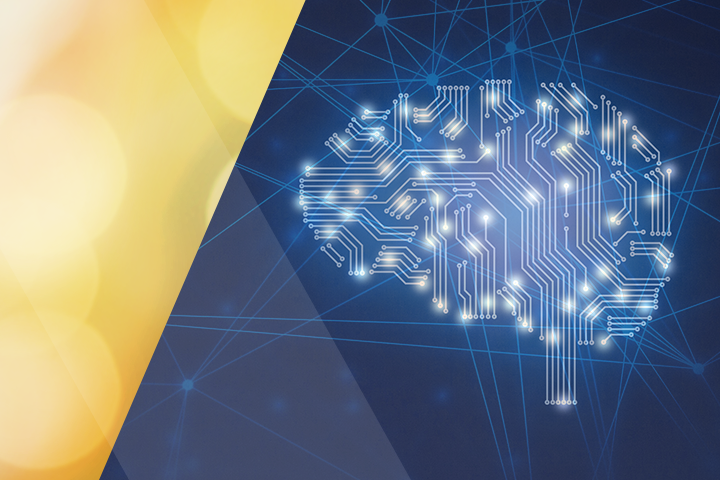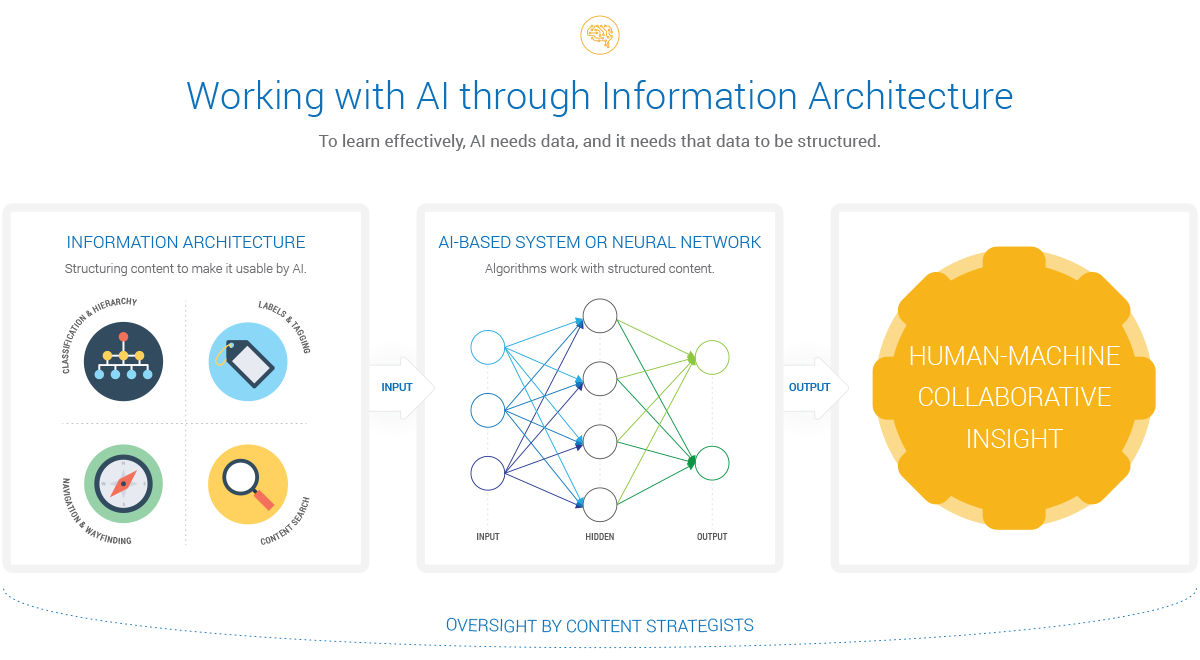The Future of Content Strategy in the Digital Enterprise

The future of content is intimately linked to the future of work. And the future of content in the age of AI is limited only by the operational capabilities of your organization. Whether content will work alongside or train AI, new innovations in content strategy, fueled by machine learning, can power digital employee experiences that will transform how people work, learn, and collaborate. Meaningful content provides the landscape on which all of this will take place.
Business leaders share a widespread belief that in the world of AI, the role of the human being will always be vital.1 Even as AI advances in machine learning, it cannot supplant human talent. As LDS has previously argued, digital experiences must consider human needs. AI will always need a humanist, empathic design through which it interacts with users. It needs the distinct language that defines the culture and identity of your enterprise. As workers increasingly partner with AI, companies are looking to build humanized experiences for workers. LDS’s Aerial Project is a case in point, in which user experience considerations inform the design of the interface. In this project, drones use AI for image processing and learning. But the user-friendly interface is the component that empowers first-responders to navigate nimbly through the digital experience in the face of disaster. Such advancements also have implications for the role of content strategists, as they consider how content can make an AI-fueled digital experience more human.
Like all technology, AI is relevant only if it can demonstrate business value, and it does so only in collaboration with human workers. But little has been said concretely about how content strategists should work with AI to enable digital experiences for workers.
As AI gains momentum across industries, business leaders must determine how it can enhance content creation, operational governance, workflow, and digital experience for employees.
Through smoother enterprise content creation and management, AI can help transform the digital employee experience into something like a customer experience. In this context, to shape the employee experience means to know where humans can work alongside machines. After all, the strategy behind digital transformation is to discover new ways of working. Even as companies begin using AI to create and manage content, they can’t pull it off successfully without a decidedly human content strategist.
Parse the role of the content strategist, and begin to see where human and machine can collaborate:
Content Ecosystem Analysis
AI can replace input-output tasks such as:
- Gathering data
- Analyzing data
- Interpreting results
- Determining a course of action
- Implementing the course of action2

The implications for content analysis are evident. Companies are already using automated systems for the quantitative analysis of content, but humans need to do much of the interpretive work. For example, Content Insights’ Content Analysis Tool (CAT) automates content inventories by crawling sites for URLs and metadata and generating reports of raw data.
But analysis doesn’t stop at the spreadsheet. A content strategist must review every page to identify gaps and interpret them vis-à-vis real-world contexts. While an AI’s interpretive capacities cover quantity and breadth, human interpretation highlights nuance, implication, and foresight.
As far as research goes, an AI can collect user data on an ongoing basis. Content strategists, on the other hand, ask those crucial open-ended questions at the beginning of the project to high-level stakeholders, giving space for talk about the business from multiple perspectives. Those smart, surprising questions that are in dialogue with stakeholders determine how automation can best serve each project. While technology can speed up the process of quantifying content, human interpretation will provide depth.
Approach to Information Architecture
Information architecture not only underpins engaging digital experiences, but it’s also vital for companies looking to take advantage of AI.
Because AI needs foundational data, metadata, and information structures whose purpose is to optimize content management, it needs solid information architecture and structured content.3
Natural language processors can learn from unlabeled and unstructured data, but human-constructed information architecture is far from obsolete. Pawan Deshpande, CEO of AI-driven content marketing software company, Curata, notes that structured content will lead to less errors that compound over time.4 This point about machine learning implies that a content strategist can be AI’s strongest teacher. Content strategists know how to make content consumable, both for humans and AI.
Structured content and robust taxonomies enable AI to complete numerous tasks. As organizations seek approaches to faster, better content creation, solutions like Automated Insights’ natural language generation software, Wordsmith, provide the ability to produce large volumes of content in short timeframes. In one notable use case, the Associated Press (AP) partnered with Automated Insights to configure Wordsmith to generate content written in AP style.5 By feeding earnings data into Wordsmith, AP can generate 3,700 quarterly earnings reports – a significant increase from the human-generated total of 300. Such advancements have multiple benefits, including making content creation scalable for organizations with few resources, and freeing workers to focus on strategic work.
For all the word processing an AI can do, human interpretive work needs to make sense of the data. Indeed, at the 2017 Intelligent Content Conference, a panel on the future of content reached the consensus that while AI and other technologies can replace repeatable content tasks, humans will still be needed to write with nuance, inference, and deduction.6 Karen Kesler, Director of Content at Microsoft, emphasized at Confab Central 2017 that they turn to artists, creative writers, and humanists who know about emotional connection to craft meaningful conversations for Cortana and develop her personality and voice. Writers with a human touch and a sense of enjoyment will go a long way for your enterprise content.
Strong information architecture can also help AI with personalizing content. Today, most content personalization is driven by recommendation engines – like those used by Amazon and Netflix – that draw from a limited base of data (typically sales history). However, companies like Toronto-based Layer 6 AI are pioneering technology that helps businesses access several types of data, including behavior, context, content, profile, location, third-party data, and real-time interaction data to drive personalization.7 Inside the enterprise, AI can make recommendations for recruiting, learning and development, talent acquisition, and employee profile matches. With more data-driven capacity, AI can learn the habits and career potential of employees and managers alike and recommend personalized paths on non-linear career journeys. But AI needs the framework that content strategists provide in guiding the plans for the right content to appear for the right people at the right time.
From Back-End to Front-End Content Design
Content strategists apply specific content design principles toward information architecture. Content principles and guidelines change from project to project, based on stakeholder interviews that human strategists conduct. Principles and guidelines also function differently for humans and AI. Whereas principles funnel into narrow, rigid paths of work for machines, guidelines can allow content strategists to work flexibly and adaptively. At the same time, content strategists can maintain strategic alignment with business goals. Anyone who works on a content strategy team knows first-hand that the balance between flexibility and consistency is an art guided by principle. AI can certainly help maintain consistency, but it cannot take over that balancing act.
Regardless of its design, enterprise content is the medium that aligns and connects leaders, employees, customers, and AI. Even as AI becomes increasingly interface-free, content remains the medium. Conversational UX like Cortana’s is only one example where natural language processing results in our ability to speak with AI assistants, free of screen or robot body. With this capability comes hyper-distributed content, the key to omnichannel experience. AI determines what content shows up, as well as when and where. But content remains.
Technology Ushers in New Collaborative Content Strategy
As cloud-based platforms enable new kinds of collaboration among humans, they can also enhance AI capabilities. In most organizations, content ownership is fragmented across different functions, like marketing or corporate communications. Increasingly, companies bridge those siloes and foster more cross-functional collaboration through cloud-based content solutions. Commenting on the potential of cloud platforms to transform content management, Oracle’s Senior Principal Product Director, Tanu Sood recently noted, “Cloud is a huge opportunity for Enterprise Content Management (ECM)…enabling business users to easily find, share, collaborate on, and drive action or interaction on content across any channel, on any device.”8 Content ownership expansion across the enterprise transforms the way employees partner together. Like the cloud-based HCM, cloud platforms for content creation offer new collection sites for measurable user data sets. Data—and lots of it—is what enables AI to function and learn. If businesses can’t see a way to apply AI because of limited data sources, cloud-based solutions are a great departure point. Cloud platforms provide a centralized site where AIs and stakeholders alike can see how employees create and handle enterprise content.
In the world of AI, the need to systematize content efforts will only grow as more actors – both human and machine – become involved in the content lifecycle.
Content strategy is the art of centralizing content efforts. Incisive content strategy gives businesses the foresight to structure digital ecosystems to meet a host of organizational goals. With new collaborative methods, content strategists can knead content to craft inspirational career journeys, foster creative collaboration, facilitate higher productivity, enable accelerated learning, and, ultimately, deliver on the Employee Value Proposition.
Where AI will take Content
In the wake of better algorithms, chatbots and assistants will reduce their dependency on fixed conversation templates. New relationships among the components of your ecosystem will come to light for insightful strategy. Organizations will also realize enterprise content as a major business asset. We see a future of cleaner content environments, multiplied user data sets, and new relationship analyses—but only if AI works for the content strategist.
AI may produce or manage large volumes of content like clockwork, and it can even do so beautifully. But, as always, content is meaningless without context. The stages of content strategy build holistic contexts that, for now, only humans can hold together.
Reimagine how your business thinks about content strategy, not as a product of business design, but as a driver of it. To do so is to reimagine new ways of empowering the workforce of the future.
- World Economic Forum Annual Meeting: The Real Impact of Artificial Intelligence
- The Rise of AI Makes Emotional Intelligence More Important
- There’s No AI (Artificial Intelligence) without IA (Information Architecture)
- Leveraging Natural Language Processing for Content Production
- Automated Insights Case Study: How Associated Press Automates Earnings Stories
- What is Intelligent Content?
- Layer 6 AI – Personalization Engine
- The Future of Content is Now
About this whitepaper
POSTED: August 4th, 2017
TAGS: content strategy, digital asset management, digital ecosystems, emerging digital solutions, enterprise content management, human-centered design, machine learning & AI

